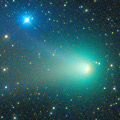
|
Now it is 6.8 mag (Dec. 22, Juan Jose Gonzalez). It keeps bright as 7 mag and observable in excellent condition until April. Then it will be fading and will be unobservable in June. In the Southern Hemisphere, it is not observable now. It will be observable in the evening low sky from April to June.
Date(TT) R.A. (2000) Decl. Delta r Elong. m1 Best Time(A, h)
Dec. 31 17 30.18 26 32.4 1.946 1.554 52 6.7 3:02 (261,-37)
Jan. 7 17 29.53 28 47.6 1.871 1.563 56 6.6 3:09 (255,-31)
|
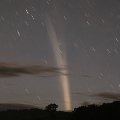
|
New Kreutz sungrazer comet discovered on the ground after 41-year blank since Comet C/1970 K1 (White-Ortiz-Bolelli). It approached nearly to the surface of the Sun on Dec. 16, and reached -4 mag or brighter at best. Then it appeared in the morning sky in the Southern Hemisphere, and it became a great comet with a bright long tail of 30-40 degrees. Now it is 5.0 mag (Dec. 29, Alexandre Amorim). In the Southern Hemisphere, it will be getting higher rapidly after this. However, the nucleus of the comet is not visible at all, fainter than 18.5 mag (Dec. 30, Hidetaka Sato). Probably the comet itself has already disappeared and only the remnant is visible. It will be fading rapidly after this. It is not observable in the Northern Hemisphere.
Date(TT) R.A. (2000) Decl. Delta r Elong. m1 Best Time(A, h)
Dec. 31 16 56.41 -58 44.7 0.552 0.663 39 7.0 3:02 (328, 20)
Jan. 7 17 26.65 -82 17.7 0.500 0.857 60 8.5 3:09 (350, 32)
|
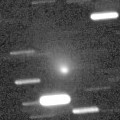
|
Now it is very bright as 9.3 mag (Dec. 22, Juan Jose Gonzalez). It will keep 10 mag until March, but it will be too low to observe. It is already unobservable in the Southern Hemisphere. It is getting lower in the evening sky also in the Northern Hemisphere. It will be lower than 10 degrees in early January.
Date(TT) R.A. (2000) Decl. Delta r Elong. m1 Best Time(A, h)
Dec. 31 20 6.93 -4 38.6 1.962 1.191 28 11.6 21:03 ( 72,-16)
Jan. 7 20 34.08 -4 43.8 1.930 1.146 27 11.2 21:02 ( 72,-16)
|

|
It was observed as bright as 13.9 mag in 2011 autumn (Oct. 19, Hidetaka Sato). It is not observable now. In the Northern Hemisphere, it will be observable again in 2012 summer, when it will be fainter than 15 mag. In the Southern Hemisphere, it will never be observable again.
Date(TT) R.A. (2000) Decl. Delta r Elong. m1 Best Time(A, h)
Dec. 31 19 30.58 -15 37.1 2.311 1.381 14 11.9 21:03 ( 58,-16)
Jan. 7 19 52.49 -12 40.1 2.294 1.363 14 11.8 21:02 ( 59,-19)
|

|
Now it is very bright as 10.8 mag (Jan. 1, Marco Goiato). In the Northern Hemisphere, it keeps observable at 11-12 mag in good condition until March, but it will be unobservable in April. In the Southern Hemisphere, it will be low in the evening sky after this.
Date(TT) R.A. (2000) Decl. Delta r Elong. m1 Best Time(A, h)
Dec. 31 0 33.18 2 34.8 1.757 2.011 89 12.1 21:03 (121, 32)
Jan. 7 0 44.58 3 27.4 1.828 2.009 85 12.2 21:02 (118, 29)
|

|
It reached up to 9.7 mag with a large bright coma in autumn (Oct. 29, Juan Jose Gonzalez). It will be fading after this. It keeps high for a while, but it will be getting lower after February. It will be unobservable in late March in the Northern Hemisphere, or late April in the Southern Hemisphere.
Date(TT) R.A. (2000) Decl. Delta r Elong. m1 Best Time(A, h)
Dec. 31 3 6.66 4 33.0 1.730 2.438 125 12.8 21:03 (166, 50)
Jan. 7 2 59.76 1 53.1 1.890 2.486 116 13.1 21:02 (153, 50)
|

|
It brightened up to 17.1 mag in late June in 2011 (June 24, J. F. Hernandez). The condition of this apparition is bad, and it is not observable around the perihelion passage. It will appear in the morning sky at 14 mag in pril in the Southern Hemisphere. It will not be observable until June in the Northern Hemisphere, when the comet will be 15.5 mag.
Date(TT) R.A. (2000) Decl. Delta r Elong. m1 Best Time(A, h)
Dec. 31 18 35.20 -26 47.3 2.554 1.574 3 13.2 3:02 (319,-15)
Jan. 7 18 59.15 -26 41.6 2.560 1.582 4 13.2 3:09 (317,-13)
|

|
It is not observable at all due to the bad condition in this apparition.
Date(TT) R.A. (2000) Decl. Delta r Elong. m1 Best Time(A, h)
Dec. 31 17 41.54 -18 34.0 2.166 1.235 13 13.4 3:02 (304,-13)
Jan. 7 18 7.35 -18 46.4 2.209 1.284 14 14.0 3:09 (302,-11)
|

|
Now it is bright as 13.3 mag (Dec. 6, Hidetaka Sato). It keeps bright as 13-14 mag for a long time after this until 2013. It is not observable in the Northern Hemisphere, but it is observable in good condition in the Southern Hemisphere.
Date(TT) R.A. (2000) Decl. Delta r Elong. m1 Best Time(A, h)
Dec. 31 23 53.77 -85 59.8 5.778 5.455 66 13.5 21:03 ( 4, 37)
Jan. 7 0 28.01 -84 18.9 5.770 5.455 66 13.5 21:02 ( 6, 38)
|

|
It brightened up to 14.1 mag in August and September (Aug. 11, Artyom Novichonok and Vladimir Gerke). Now it is not observable. It will appear in the morning sky at 14 mag at the end of February. Then it will be observable in good condition in the Southern Hemisphere while fading gradually. It will locate somewhat low in the Northern Hemisphere. In 2011, some visual observers reported it was very bright as 10-12 mag.
Date(TT) R.A. (2000) Decl. Delta r Elong. m1 Best Time(A, h)
Dec. 31 18 23.66 -13 31.1 3.312 2.351 10 13.7 3:02 (308,-23)
Jan. 7 18 39.72 -14 0.6 3.316 2.358 10 13.7 3:09 (304,-20)
|
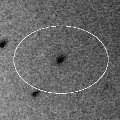
|
Now it is bright as 13.8 mag (Dec. 30, Alan Hale). Strongly condensed, and it seems to be soon after an outburst.
Date(TT) R.A. (2000) Decl. Delta r Elong. m1 Best Time(A, h)
Dec. 31 12 37.73 -12 6.3 6.264 6.262 85 14.0 3:02 (252, 43)
Jan. 7 12 39.14 -12 27.1 6.150 6.261 91 13.9 3:09 (245, 50)
|
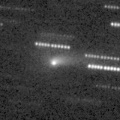
|
It reached up to 11-12 mag in 2011 autumn. Now it is fading, but still bright as 12.8 mag and visible visually (Dec. 3, Marco Goiato). It keeps observable in good condition until May when it becomes fainter than 18 mag. It locates somewhat low in the Southern Hemisphere.
Date(TT) R.A. (2000) Decl. Delta r Elong. m1 Best Time(A, h)
Dec. 31 11 59.95 11 10.1 1.099 1.632 103 14.2 3:02 (223, 33)
Jan. 7 12 10.28 12 31.7 1.077 1.669 108 14.4 3:09 (216, 35)
|

|
Big asteroid discovered in 1906. It suddenly showed the cometary activity on Dec. 11, 2010, probably due to an impact of a small object. It was very bright as 11.5 mag visually (Dec. 17, 2010, Juan Jose Gonzalez). It had a dust coma still on Jan. 9, 2011 (Joseph Brimacombe). Then it turned to be stellar at 13.8 mag (Apr. 5, Juan Jose Gonzalez). Appearing in the morning sky in the Northern Hemisphere.
Date(TT) R.A. (2000) Decl. Delta r Elong. m1 Best Time(A, h)
Dec. 31 15 8.81 -9 6.2 3.006 2.521 51 14.2 3:02 (273, 11)
Jan. 7 15 19.97 -9 58.1 2.927 2.514 56 14.2 3:09 (271, 16)
|

|
Now it is 14.3 mag and visible visually (Oct. 1, Jakub Cerny). It will be observable at 13-14 mag for a long time from 2011 to 2012. However, it will be unobservable temporarily from November to January.
Date(TT) R.A. (2000) Decl. Delta r Elong. m1 Best Time(A, h)
Dec. 31 18 6.40 -14 6.5 6.154 5.196 11 14.3 3:02 (305,-20)
Jan. 7 18 8.21 -14 10.3 6.122 5.187 16 14.3 3:09 (299,-14)
|

|
It was expected to keep 14-15 mag for a long time from 2011 summer to 2012 summer. However, it is lost. It was observed only during two days in 2010 June. So the orbital elements are extremely uncertain. The condition is good in the Southern Hemisphere. But in the Northern Hemisphere, it is not observable until 2012 August.
Date(TT) R.A. (2000) Decl. Delta r Elong. m1 Best Time(A, h)
Dec. 31 20 1.35 -70 38.7 2.864 2.340 49 14.5 21:03 ( 20, 26)
Jan. 7 20 47.83 -70 53.4 2.825 2.327 50 14.4 21:02 ( 20, 27)
|

|
First return of a new comet which brightened up to 9.5 mag in a major outburst in 2006. It was recovered on Dec. 17, but much fainter than expected. However, it looks very diffuse, and the total magnitude is bright as 13.5 mag (Dec. 26, Michael Jager). It will approach to the earth down to 0.24 A.U. in January, and will be observable in excellent condition. It may be visible visually.
Date(TT) R.A. (2000) Decl. Delta r Elong. m1 Best Time(A, h)
Dec. 31 23 56.94 20 40.5 0.318 1.029 89 15.0 21:03 (127, 14)
Jan. 7 0 32.10 16 2.9 0.285 1.014 87 14.5 21:02 (126, 18)
|

|
Now it is visible visually at 13.6 mag (Nov. 27, Jakub Cerny). It is expected to be 13 mag and will be observable in good condition in 2013. In the Northern Hemisphere, it keeps observable for a long time after this. It is not observable in the Southern Hemisphere.
Date(TT) R.A. (2000) Decl. Delta r Elong. m1 Best Time(A, h)
Dec. 31 22 55.07 53 19.6 6.734 6.879 94 14.7 21:03 (143,-18)
Jan. 7 22 55.17 52 23.1 6.792 6.855 89 14.7 21:02 (140,-21)
|

|
It is expected to be bright as 9 mag from 2012 to 2013. Now it is 14.9 mag (Dec. 1, P. Dupouy). In the Northern Hemisphere, it keeps observable in good condition for a long time until 2012 autumn when the comet brightens up to 10 mag. In the Southern Hemisphere, it is hardly observble before the perihelion passage. But it becomes observable in good condition since 2013 after the perihelion passage.
Date(TT) R.A. (2000) Decl. Delta r Elong. m1 Best Time(A, h)
Dec. 31 14 55.14 44 10.7 4.569 4.579 84 14.9 3:02 (228,-17)
Jan. 7 15 2.78 44 34.5 4.453 4.517 87 14.8 3:09 (224,-13)
|
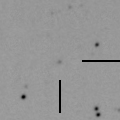
|
It brightened up to 16.6 mag on Oct. 12 (Hidetaka Sato). But it is not observable now. It will keep unobservable until it becomes fainter than 18 mag.
Date(TT) R.A. (2000) Decl. Delta r Elong. m1 Best Time(A, h)
Dec. 31 19 27.62 -23 41.1 2.540 1.588 11 15.0 21:03 ( 51,-10)
Jan. 7 19 50.20 -22 24.3 2.560 1.598 9 15.1 21:02 ( 52,-12)
|
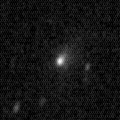
|
It brightened up to 12.3 mag around the perihelion passage, although it located very low (Oct. 19, Hidetaka Sato). Now it is 13.7 mag (Dec. 6, Hidetaka Sato). The condition of this apparition is bad. In the Northern Hemisphere, it is only observable from December to February in the evening very low sky. In the Southern Hemisphere, it keeps observable for a long time, although it keeps locating extremely low. The component B was not detected, fainter than 20 mag, on May 14 (Hidetaka Sato).
Date(TT) R.A. (2000) Decl. Delta r Elong. m1 Best Time(A, h)
Dec. 31 21 38.90 -22 29.2 1.980 1.404 41 15.1 21:03 ( 71, 12)
Jan. 7 22 3.58 -20 18.9 2.069 1.469 40 15.5 21:02 ( 73, 11)
|

|
Now it is 15.2 mag (Dec. 11, Toshiyuki Takahashi). It is getting lower in the evening sky. It will be unobservable in late January in the Northern Hemisphere, or in mid March in the Southern Hemisphere. It is expected to be observable at 13 mag for a long time from 2012 summer to 2013 summer. It will be observable in excellent condition in the Southern Hemisphere. But it is not observable at brightest time in the Northern Hemisphere.
Date(TT) R.A. (2000) Decl. Delta r Elong. m1 Best Time(A, h)
Dec. 31 1 10.03 -34 21.2 3.854 3.864 83 15.3 21:03 ( 80, 59)
Jan. 7 1 6.91 -34 11.6 3.901 3.805 77 15.3 21:02 ( 78, 53)
|

|
It was observed so bright as 9.4 mag in September (Sept. 22, Chris Wyatt). It is still bright as 14.5 mag (Dec. 7, Artyom Novichonok). It will be observable while fading gradually after this. In the Southern Hemisphere, further observations are very hard. Carlos Labordena reported it is very bright as 11.6 mag visually on Dec. 23.
Date(TT) R.A. (2000) Decl. Delta r Elong. m1 Best Time(A, h)
Dec. 31 14 25.85 19 19.5 1.893 1.890 74 15.9 3:02 (244, 3)
Jan. 7 14 20.94 23 21.8 1.817 1.968 83 16.2 3:09 (235, 7)
|

|
Now it is bright as 16.2 mag (Dec. 13, V. Gerke, S. Plaksa, A. Novichonok). Although it was extremely faint as 20.5 mag at the recovery in 2010 autumn, it brightened rapidly. It will keep 15 mag and observable in good condition for a long time from 2012 to 2013. But it locates somewhat low in the Northern Hemisphere in 2013.
Date(TT) R.A. (2000) Decl. Delta r Elong. m1 Best Time(A, h)
Dec. 31 13 15.81 9 23.4 3.443 3.500 85 16.3 3:02 (240, 22)
Jan. 7 13 21.09 9 19.1 3.328 3.483 90 16.2 3:09 (235, 27)
|
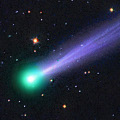
|
It passed very near by the earth, within 0.1 A.U., and brightened up to 8.0 mag in the southern sky (Aug. 14, Willian Souza). After appearing in the morning sky in late September, it brightened up to 6.6 mag (Sept. 25, Juan Jose Gonzalez). Now it is fading. It has already faded down to 15.7 mag (Dec. 11, Ken-ichi Kadota).
Date(TT) R.A. (2000) Decl. Delta r Elong. m1 Best Time(A, h)
Dec. 31 13 55.53 -7 28.9 1.743 1.672 69 16.6 3:02 (261, 25)
Jan. 7 14 1.94 -7 49.3 1.737 1.758 74 16.9 3:09 (257, 31)
|

|
First return of a new periodic comet which brightened up to 13 mag in a major outburst in 2005. In this apparition, it brightened up to 12 mag in 2011 summer and autumn. Now it is fading. It has already faded down to 16.8 mag (Dec. 18, Toshiyuki Takahashi). It keeps observable in good condition until February when it fades out down to 17-18 mag. Its fragments have not been observed since early October.
Date(TT) R.A. (2000) Decl. Delta r Elong. m1 Best Time(A, h)
Dec. 31 23 38.38 8 7.4 2.513 2.529 79 16.6 21:03 (115, 18)
Jan. 7 23 47.87 8 55.8 2.623 2.553 75 16.8 21:02 (112, 15)
|
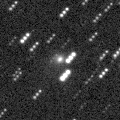
|
Although it has passed the perihelion in 2010 November, it is uxexpectedly bright as 16.4 mag still now (Dec. 17, J. Nicolas). It keeps observable in excellent condition for a while. It will keep 16-17 mag for a while after this.
Date(TT) R.A. (2000) Decl. Delta r Elong. m1 Best Time(A, h)
Dec. 31 6 11.65 6 52.5 3.955 4.902 162 16.6 23:32 (180, 48)
Jan. 7 6 3.81 7 49.4 4.023 4.951 158 16.7 22:57 (180, 47)
|

|
It had expected to keep 17 mag for a long time from 2011 summer to 2012 spring and observable in good condition in the Southern Hemisphere. But actually, no observations have been reported since August. Maybe it has already disappeared. In the Northern Hemisphere, it is not observable until March when it becomes fainter than 18 mag.
Date(TT) R.A. (2000) Decl. Delta r Elong. m1 Best Time(A, h)
Dec. 31 12 6.31 -73 59.0 2.197 2.077 69 16.9 3:02 (346, 47)
Jan. 7 11 24.81 -74 32.6 2.139 2.109 74 16.9 3:09 (352, 49)
|

|
Now it is 16.2 mag (Dec. 13, V. Gerke, A. Novichonok). It will be getting lower gradually after this, and will be unobservable in March. It is not observable in the Southern Hemisphere.
Date(TT) R.A. (2000) Decl. Delta r Elong. m1 Best Time(A, h)
Dec. 31 22 57.84 34 5.1 5.803 5.785 84 16.9 21:03 (128, -6)
Jan. 7 23 3.37 33 25.5 5.926 5.819 78 17.0 21:02 (125, -9)
|
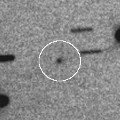
|
Now it is 17.3 mag (Dec. 21, H. Mikuz). It tends to be brightest after the perihelion passage. It is observable in excellent condition in the Northern Hemisphere. It locates somewhat low in the Southern Hemisphere. It will be fainter than 18 mag in March.
Date(TT) R.A. (2000) Decl. Delta r Elong. m1 Best Time(A, h)
Dec. 31 11 20.32 22 54.1 1.942 2.530 115 16.9 3:02 (207, 27)
Jan. 7 11 21.60 23 53.3 1.906 2.571 122 17.0 3:09 (198, 29)
|

|
It became bright as 12 mag in 2010. Now it is fading. It has already faded down to 16.2 mag (Nov. 14, V. Gerke, A. Novichonok, S. Plaksa).
Date(TT) R.A. (2000) Decl. Delta r Elong. m1 Best Time(A, h)
Dec. 31 1 28.84 2 37.4 3.720 4.051 102 16.9 21:03 (134, 41)
Jan. 7 1 30.38 3 5.7 3.844 4.068 96 17.0 21:02 (128, 37)
|
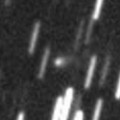
|
Now it is 16.7 mag (Dec. 5, Hidetaka Sato), brighter than the early ephemeris. It keeps observable in good condition for a while after this. It keeps 17 mag until February.
Date(TT) R.A. (2000) Decl. Delta r Elong. m1 Best Time(A, h)
Dec. 31 7 48.45 1 7.4 1.420 2.336 152 16.9 1:14 (180, 54)
Jan. 7 7 43.54 0 38.0 1.409 2.344 156 16.9 0:41 (180, 54)
|

|
Now it is 16.4 mag (Nov. 23, Catalina Sky Survey). It was observed at 17.5 mag in 2011 spring, when the condition was good in the Southern Hemisphere. It will be observable at 17 mag in this winter, when the condition is good in the Northern Hemisphere.
Date(TT) R.A. (2000) Decl. Delta r Elong. m1 Best Time(A, h)
Dec. 31 9 5.06 33 53.8 1.599 2.478 146 17.0 2:31 (180, 21)
Jan. 7 8 30.39 37 21.9 1.583 2.517 157 17.0 1:30 (180, 18)
|

|
It brightened up to 13-14 mag and became visible visually from 2007 to 2009. Now it is fading. But it is still bright as 17.6 mag (Dec. 11, Ken-ichi Kadota). In the Northern Hemisphere, it keeps observable in excellent condition until early summer in 2012. In the Southern Hemisphere, it locates extremely low only.
Date(TT) R.A. (2000) Decl. Delta r Elong. m1 Best Time(A, h)
Dec. 31 10 49.47 37 51.8 10.569 11.161 124 17.1 3:02 (195, 15)
Jan. 7 10 46.77 38 14.8 10.525 11.197 131 17.1 3:09 (187, 16)
|
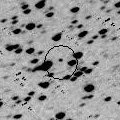
|
Peculiar asteroid moving along a cometary orbit. Now it is 18.4 mag (Oct. 26, Hidetaka Sato). It keeps observable at 18 mag for a long time from 2008 to 2014.
Date(TT) R.A. (2000) Decl. Delta r Elong. m1 Best Time(A, h)
Dec. 31 7 50.30 11 54.5 5.698 6.628 159 17.2 1:16 (180, 43)
Jan. 7 7 45.25 12 38.4 5.673 6.635 166 17.1 0:43 (180, 42)
|
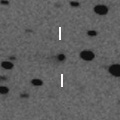
|
Now it is 17.6 mag (Dec. 11, Ken-ichi Kadota). It is already unobservable in the Southern Hemisphere. It will be getting lower rapidly in the evening and will be unobservable in February also in the Northern Hemisphere.
Date(TT) R.A. (2000) Decl. Delta r Elong. m1 Best Time(A, h)
Dec. 31 23 26.27 10 58.5 8.259 8.115 78 17.2 21:03 (115, 14)
Jan. 7 23 25.85 10 47.7 8.386 8.122 71 17.2 21:02 (110, 9)
|

|
Now it is 17.2 mag (Dec. 18, J. F. Hernandez). It keeps observable at 18 mag for a long time until 2013.
Date(TT) R.A. (2000) Decl. Delta r Elong. m1 Best Time(A, h)
Dec. 31 5 11.33 25 57.0 2.980 3.919 160 17.3 22:33 (180, 29)
Jan. 7 5 7.48 25 49.9 3.022 3.919 152 17.3 22:01 (180, 29)
|
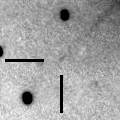
|
Now it is 16.5 mag (Dec. 21, K. Hills). It keeps 17-18 mag until early 2013. It keeps observable in good condition until early 2012 in the Southern Hemisphere, although it locates low in the Northern Hemisphere. In the Northern Hemisphere, it will be observable in good condition from 2012 autumn to early 2013.
Date(TT) R.A. (2000) Decl. Delta r Elong. m1 Best Time(A, h)
Dec. 31 0 38.31 -30 38.1 3.115 3.074 78 17.3 21:03 ( 84, 52)
Jan. 7 0 43.56 -28 36.7 3.174 3.055 74 17.4 21:02 ( 84, 47)
|
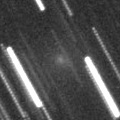
|
Extremely diffuse and hardly detected by CCD images. The nucleus is already fainter than 18 mag (Oct. 15, Jean-Francois Soulier). The comet can be already disintegrated. However, Juan Jose Gonzalez reported it so bright as 9.5 mag visually on Sept. 25. It is observable in good condition in the Southern Hemisphere. It locates extremely low in the Northern Hemisphere. No observations have been reported since October.
Date(TT) R.A. (2000) Decl. Delta r Elong. m1 Best Time(A, h)
Dec. 31 11 39.36 -40 17.7 1.897 2.069 85 17.4 3:02 (291, 65)
Jan. 7 11 29.90 -43 54.9 1.908 2.158 90 17.5 3:09 (306, 72)
|
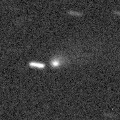
|
It was revealed to be a comet when appearing in the morning sky in early August. It was visible as 13.8 mag and visible visually (Sept. 4, Sandor Szabo). Now it is fading. It has already faded down to 17.6 mag (Dec. 23, G. Hug). In the Northern Hemisphere, it keeps observable in excellent condition for a long time until 2012 summer. But it will be fainter than 18 mag in late January. It is not observable at all in the Southern Hemisphere.
Date(TT) R.A. (2000) Decl. Delta r Elong. m1 Best Time(A, h)
Dec. 31 12 5.43 52 37.5 2.629 3.147 113 17.4 3:02 (202, -3)
Jan. 7 12 5.33 53 38.1 2.627 3.200 117 17.6 3:09 (196, -2)
|

|
Now it is 15.6 mag (Dec. 17, Ken-ichi Kadota), brighter than this ephemeris. Hidetaka Sato reported a small outburst occured in early December. In the Northern Hemisphere, it keeps locating the same altitude in the morning sky. In the Southern Hemisphere, it locates extremely low now, but it will be getting higher gradually. The ephemeris says it will be fainter than 18 mag in late January. But it may keep brighter some more time.
Date(TT) R.A. (2000) Decl. Delta r Elong. m1 Best Time(A, h)
Dec. 31 14 1.60 -28 17.3 1.689 1.498 61 17.4 3:02 (283, 34)
Jan. 7 14 16.55 -30 23.0 1.707 1.567 64 17.6 3:09 (283, 39)
|
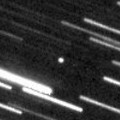
|
Now it is 17.5 mag (Nov. 5, LINEAR). It keeps observable in good condition at 17-18 mag until March. It locates low in the Southern Hemisphere.
Date(TT) R.A. (2000) Decl. Delta r Elong. m1 Best Time(A, h)
Dec. 31 1 54.27 25 55.7 1.290 1.937 116 17.5 21:03 (154, 24)
Jan. 7 1 48.51 23 59.7 1.340 1.885 107 17.6 21:02 (146, 22)
|

|
It is expected to keep 13 mag and observable in good condition in the Northern Hemisphere for a long time from 2013 to 2014. Now it is 18.3 mag (Nov. 7, Hidetaka Sato). It keeps observable at 17-18 mag in good condition until June.
Date(TT) R.A. (2000) Decl. Delta r Elong. m1 Best Time(A, h)
Dec. 31 11 33.38 -2 54.0 6.755 7.053 103 17.6 3:02 (227, 48)
Jan. 7 11 31.99 -2 30.0 6.590 7.007 111 17.5 3:09 (214, 53)
|
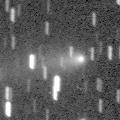
|
It had been fading after the perihelion passage in 2010 October, but it brightened again in outburst on Apr. 5, 2011. It reached up to 14.7 mag in May (May 28, Hidetaka Sato). It has been unobservable since July. But it is appearing in the morning sky now. Now it is 17.3 mag, much brighter than expected (Nov. 26, Hidetaka Sato). It locates low in the Southern Hemisphere. But in the Northern Hemisphere, it keeps observable in good condition after this. It will keep 17 mag for a while.
Date(TT) R.A. (2000) Decl. Delta r Elong. m1 Best Time(A, h)
Dec. 31 13 36.03 14 40.5 3.683 3.694 82 17.6 3:02 (240, 15)
Jan. 7 13 40.28 14 50.9 3.613 3.723 88 17.6 3:09 (234, 20)
|

|
Now it is 17.6 mag (Dec. 16, J. Gonzalez). It will be fainter than 18 mag in late January.
Date(TT) R.A. (2000) Decl. Delta r Elong. m1 Best Time(A, h)
Dec. 31 2 55.87 -14 38.8 3.504 4.003 113 17.8 21:03 (151, 67)
Jan. 7 2 55.86 -14 14.0 3.586 4.000 107 17.8 21:02 (138, 64)
|
|
![]()
 C/2009 F4 ( McNaught )
C/2009 F4 ( McNaught ) C/2011 A3 ( Gibbs )
C/2011 A3 ( Gibbs ) 29P/Schwassmann-Wachmann 1
29P/Schwassmann-Wachmann 1 49P/Arend-Rigaux
49P/Arend-Rigaux (596) Scheila
(596) Scheila C/2006 S3 ( LONEOS )
C/2006 S3 ( LONEOS ) C/2010 M1 ( Gibbs )
C/2010 M1 ( Gibbs ) P/2006 T1 = P/2011 Y1 ( Levy )
P/2006 T1 = P/2011 Y1 ( Levy ) C/2010 S1 ( LINEAR )
C/2010 S1 ( LINEAR ) C/2011 F1 ( LINEAR )
C/2011 F1 ( LINEAR ) 37P/Forbes
37P/Forbes 73P/Schwassmann-Wachmann 3
73P/Schwassmann-Wachmann 3 C/2011 R1 ( McNaught )
C/2011 R1 ( McNaught ) C/2011 Q4 ( SWAN )
C/2011 Q4 ( SWAN ) 246P/2010 V2 ( NEAT )
246P/2010 V2 ( NEAT ) 45P/Honda-Mrkos-Pajdusakova
45P/Honda-Mrkos-Pajdusakova 213P/2009 B3 ( Van Ness )
213P/2009 B3 ( Van Ness ) C/2010 FB87 ( WISE-Garradd )
C/2010 FB87 ( WISE-Garradd ) C/2011 L2 ( McNaught )
C/2011 L2 ( McNaught ) C/2008 FK75 ( Lemmon-Siding Spring )
C/2008 FK75 ( Lemmon-Siding Spring ) 164P/Christensen
164P/Christensen 65P/Gunn
65P/Gunn P/2011 W2 ( Rinner )
P/2011 W2 ( Rinner ) C/2011 G1 ( McNaught )
C/2011 G1 ( McNaught ) C/2005 L3 ( McNaught )
C/2005 L3 ( McNaught ) 2008 YB3
2008 YB3 C/2008 S3 ( Boattini )
C/2008 S3 ( Boattini ) 244P/2010 Q1 ( Scotti )
244P/2010 Q1 ( Scotti ) P/2011 N1 ( ASH )
P/2011 N1 ( ASH ) C/2011 M1 ( LINEAR )
C/2011 M1 ( LINEAR ) P/2010 JC81 ( WISE )
P/2010 JC81 ( WISE ) C/2011 S2 ( Kowalski )
C/2011 S2 ( Kowalski ) (3200) Phaethon
(3200) Phaethon C/2011 J2 ( LINEAR )
C/2011 J2 ( LINEAR ) 240P/2010 P1 ( NEAT )
240P/2010 P1 ( NEAT ) 242P/2010 P3 ( Spahr )
242P/2010 P3 ( Spahr )![]()








































